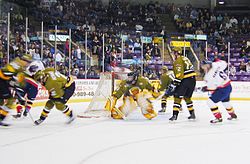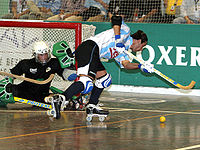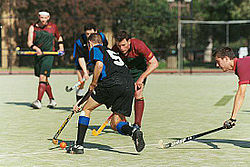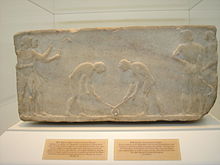 stating in Basketball game.
stating in Basketball game.
Basketball is a team sport, the objective being to shoot a ball through a basket horizontally positioned to score points while following a set of rules. Usually, two teams of five players play on a marked rectangular court with a basket at each width end. Basketball is one of the world's most popular and widely viewed sports
In early December 1891,
Canadian American Dr.
James Naismith,
[2] a physical education professor and instructor at the International Young Men's Christian Association Training School
[3] (YMCA) (today,
Springfield College) in
Springfield, Massachusetts, USA), was trying to keep his gym class active on a rainy day. He sought a vigorous indoor game to keep his students occupied and at proper levels of fitness during the long
New England winters. After rejecting other ideas as either too rough or poorly suited to walled-in
gymnasiums, he wrote the basic
rules and nailed a
peach basket onto a 10-foot (3.05 m) elevated track. In contrast with modern basketball nets, this peach basket retained its bottom, and balls had to be retrieved manually after each "basket" or point scored; this proved inefficient, however, so the bottom of the basket was removed,
[4] allowing the balls to be poked out with a long
doweleach time.
Basketball was originally played with a
soccer ball. The first balls made specifically for basketball were brown, and it was only in the late 1950s that
Tony Hinkle, searching for a ball that would be more visible to players and spectators alike, introduced the orange ball that is now in common use. Dribbling was not part of the original game except for the "bounce pass" to teammates. Passing the ball was the primary means of ball movement. Dribbling was eventually introduced but limited by the asymmetric shape of early balls. Dribbling only became a major part of the game around the 1950s, as manufacturing improved the ball shape.
The peach baskets were used until 1906 when they were finally replaced by metal hoops with backboards. A further change was soon made, so the ball merely passed through. Whenever a person got the ball in the basket, his team would gain a point. Whichever team got the most points won the game.
[5]The baskets were originally nailed to the mezzanine balcony of the playing court, but this proved impractical when spectators on the balcony began to interfere with shots. The backboard was introduced to prevent this interference; it had the additional effect of allowing rebound shots.
[6] Naismith's handwritten diaries, discovered by his granddaughter in early 2006, indicate that he was nervous about the new game he had invented, which incorporated rules from a children's game called "
Duck on a Rock", as many had failed before it. Naismith called the new game "Basket Ball".
[7] The first official game was played in the
YMCA gymnasium in Albany, New York on January 20, 1892 with nine players. The game ended at 1–0; the shot was made from 25 feet (7.6 m), on a court just half the size of a present-day
Streetball or
National Basketball Association (NBA) court. By 1897–1898 teams of five became standard.
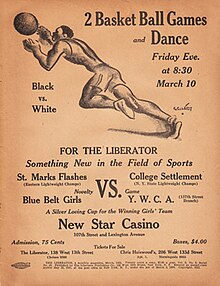
With the NCAA basketball season due to start in October, everyone is looking forward to finding out how there college is getting on and how their games are going. What better way than following the action and tuning in to listen to live NCAA basketball on the radio.
There are many radio stations that will bring you the games as they happen and you will find that you will probably have a choice if you decide that you would like to keep informed and listen to live NCAA basketball. With internet access being so readily available now, you can easily search for a radio station that is featuring the game that you want to hear and some will even be able to give you coverage via your computer.
Some colleges have their own radio station and you will find that it is easy to listen to live NCAA basketball brought to you by your own college radio. If they do have a station then it will guarantee that you will never have to search around to find a local station that is featuring the game. If, however, your college does not have a station, then you will find that you can usually get coverage via Yahoo Sports. Here they have a huge selection of games that they will cover as they happen. All you have to do is go to Yahoo Sports and choose which one you want to hear.
Many local radio stations will also feature coverage of the games and if you log on to their websites you will probably find that they have a schedule and, during the season, will give a list of when the games are and which ones you can tune in to. Not only can you listen to live NCAA basketball, but often they will cover football and hockey too. Sirius.com is another website that offers a comprehensive college sports coverage service and here you will be able to listen to all the college games. Not only do they cover nearly all the games in the NCAA basketball schedule, but they also have some interesting programs with discussions regarding the games and interviews with coaches. With packages such as Sirius, you can choose whether to subscribe to satellite radio in your car, at home or online. Once you have subscribed and been connected, you will have a huge range of college sports to listen to whenever you wish, as well as all the other programs which are available. These include music and chat shows as well as current affairs programs.
With college basketball being one of the most popular sports in America, you will find that it is easy to listen to live NCAA basketball and you will have no excuse for not following your college as they head for March Madness.
Robert Grazian is an accomplished niche website developer and author. To learn more about college sports [http://bestcollegesports.info/listen-to-live-ncaa-basketball] visit Best College Sports [http://bestcollegesports.info] for current articles and discussions.
Article Source: http://EzineArticles.com/1492001.

 The only essential equipment in a basketball game is the ball and the court: a flat, rectangular surface with baskets at opposite ends. Competitive levels require the use of more equipment such as clocks, score sheets, scoreboard(s), alternating possession arrows, and whistle-operated stop-clock systems.
The only essential equipment in a basketball game is the ball and the court: a flat, rectangular surface with baskets at opposite ends. Competitive levels require the use of more equipment such as clocks, score sheets, scoreboard(s), alternating possession arrows, and whistle-operated stop-clock systems.

An outdoor basketball net.
A regulation
basketball court in international games is 91.9 feet long and 49.2 feet wide. In the
NBA and
NCAA the court is 94 feet by 50 feet. Most courts have
wood flooring, usually constructed from
maple planks running in the same direction as the longer court dimension.
[38] The name and logo of the home team is usually painted on or around the center circle.
The basket is a steel rim 18 inches diameter with an attached net affixed to a backboard that measures 6 feet by 3.5 feet and one basket is at each end of the court. The white outlined box on the backboard is 18 inches high and 2 feet wide. At almost all levels of competition, the top of the rim is exactly 10 feet above the court and 4 feet inside the baseline. While variation is possible in the dimensions of the court and backboard, it is considered important for the basket to be of the correct height – a rim that is off by just a few inches can have an adverse effect on shooting.
The size of the basketball is also regulated. For men, the official ball is 29.5 inches in circumference (size 7, or a "295 ball") and weighs 22 oz. If women are playing, the official basketball size is 28.5 inches in circumference (size 6, or a "285 ball") with a weight of 20 oz.Here they are! The brand new Carmelo Anthony signature sneaker we all have been waiting for was unveiled today. There is now officially a new pair of Jordans waiting to be copped. And we won't have to wait very long. The new Melo M8 is scheduled to drop on October 12th, 2011. Carmelo's eighth signature sneaker brings a fresh start to his career. This will be the first new signature sneaker he laces up with the New York Knicks. Traded on February 22, 2011 from the Denver Nuggets to the Knicks with Chauncey Billups, Melo now has the talent around him to make a run at the NBA Finals Championship. And, of course, he will have plenty of colorways of the Melo M8 to rock on his quest to be a champion for the first time.
The Melo M8, like the Melo M7 Advance, features Nike Flywire technology on the shoe's upper. Carmelo has always wanted lightweight stability in a shoe and there is no better technology to provide those qualities in a shoe than Flywire. There is plenty of cushioning in the shoe to complement the upper. Both Nike Zoom Air and Max Air are used in the midsole. Exposed Zoom Air contained in a TPU chasis is used in the forefoot while a Max Air unit has been placed in the heel. There is a new Melo Sheild that is used to complete the shoe. The shield was created by Melo and is a tribute to his family and New York City heritage.
What would any high profile signauture sneaker be without a multitude of sick colorways? Boring. That's what. But fear not, the new Melo M8 will definitely not be boring. Already, pictures of 5 different colorways of the shoe have been spotted. So far we have seen two Knick colorways, a home and away. Both shoes use patent leather, one has a white upper, the other a black upper. In addition, Cool Grey, Black, and White/Black/Red colorways are already slated for release in the next couple of months. The home and away Knicks colorways are sure to be a hit and release October 12. The Cool Grey colorway will drop sometime in November. Of course, these are just the initial colorways, there are sure to be more.
This week has been a very good week for sneakerheads. Several of the some high profile Jordan shoes for basketball have been unveiled. The new Melo M8 is one of those Jordan signature sneakers that was unveiled. And it was unveiled is some pretty sick colorways. This is a shoe that can definitely not be called boring.
Unusually, for team sports, it is known exactly who invented basketball and exactly when it was invented. It is more usual for such a sport to have just evolved and have no clear starting point and no name for an actual inventor of the game.
It was a Mr James A Naismith who invented basketball. He was born on November 6th 1861 and died on November 28th 1939. He was born a Canadian near Ontario in the Ramsay township. His parents were Scottish immigrants who had crossed the Atlantic in around 1851. His father, John, was involved in the mining industry. As a youngster, James was always athletic and was a great gymnast. He also played football for McGill University where he was studying physical education. After gaining a BA in the subject, James attended the Presbyterian College in Montreal and went on to gain a Diploma.
After his studies, James Naismith started working as a teacher at the YMCA in Springfield, Massachusetts. It was whilst he was here that he was asked to come up with a game for the students that could be played indoors. He had various stipulations to work to regarding the size of the room and the number of people etc. He remembered playing a game by the name of "duck on a rock" as a child and decided to implement some of the ideas into his new game. The game involved two teams with nine players in each team, a ball and two peach baskets - one nailed to each end of the gymnasium. The principle was simple; you had to pass the ball to your team members and then score a goal by throwing it into the peach basket. The game was an instant success and the name of James Naismith has gone down in history as the man who invented basketball.
Before widespread school district consolidation, most American high schools were far smaller than their present-day counterparts. During the first decades of the 20th century, basketball quickly became the ideal interscholastic sport due to its modest equipment and personnel requirements. In the days before widespread television coverage of professional and college sports, the popularity of high school basketball was unrivaled in many parts of America. Perhaps the most legendary of high school teams was Indiana's
Franklin Wonder Five, which took the nation by storm during the 1920s, dominating Indiana basketball and earning national recognition.
Today virtually every high school in the United States fields a basketball team in
varsity competition.
[12] Basketball's popularity remains high, both in rural areas where they carry the identification of the entire community, as well as at some larger schools known for their basketball teams where many players go on to participate at higher levels of competition after graduation. In the 2003–04 season, 1,002,797 boys and girls represented their schools in interscholastic basketball competition, according to the
National Federation of State High School Associations. The states of
Illinois,
Indiana and
Kentucky are particularly well known for their residents' devotion to high school basketball, commonly called
Hoosier Hysteria in Indiana; the critically acclaimed film
Hoosiers shows high school basketball's depth of meaning to these communities.
There is currently no national tournament to determine a national high school champion. The most serious effort was the National Interscholastic Basketball Tournament at the
University of Chicago from 1917 to 1930. The event organized by
Amos Alonzo Stagg and sent invitations to state champion teams. The tournament started out as a mostly Midwest affair but grew. In 1929 it had 29 state champions. Faced with opposition from the
National Federation of State High School Associations and
North Central Association of Colleges and Schools that bore a threat of the schools losing their accreditation the last tournament was in 1930. The organizations said they were concerned that the tournament was being used to recruit professional players from the prep ranks.
[13] The tournament did not invite minority schools or private/parochial schools.
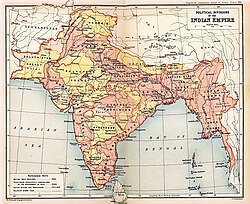 Times of india.
Times of india.













